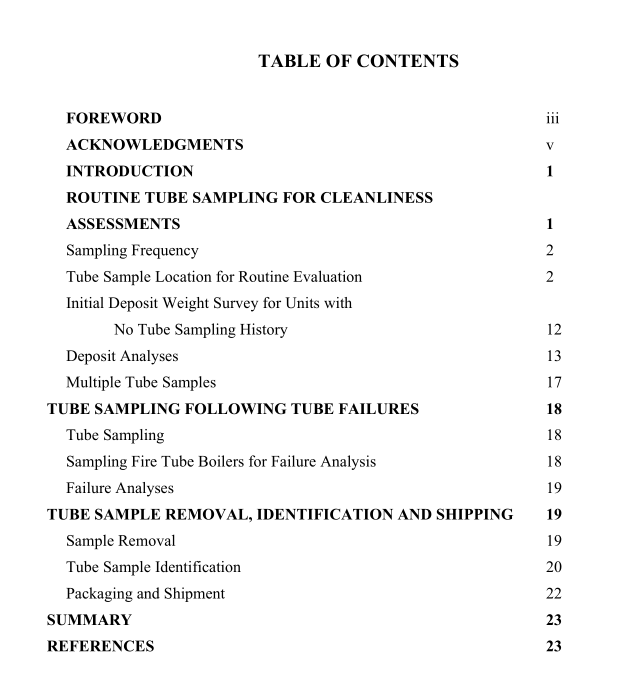ASME CRTD-103 pdf download

ASME CRTD-103 pdf download CONSENSUS ON BEST TUBE SAMPLING PRACTICES FOR BOILERS & NONNUCLEAR STEAM GENERATORS
The boiler or HRSG manufacturer recommendations, Table 1, and consideration of the preceding criteria should aid the user in identifying appropriate tube sample locations. The following list provides other areas and factors to consider for these and other boiler or HRSG designs when selecting tube sample locations. ? Angled Wall-Fired (Turbo Furnace) Boilers. In this design (Figure 6) the middle of the furnace is narrower than above or below the burners. In units with burners mounted in angled front and rear walls (i.e., in which the burners protrude directly from these downward sloped sections of walls and therefore angle down into the furnace), consider the following areas: in the slope around the burners, in the reverse slope tubes just above the burners and from the side wall about 1/5-1/4 of the distance from the rear burner wall. The preferred locations can be unit-specific and so they were not included in Table 1.
Wall-Fired Boilers with Roof or Nose Tubes. Over extended periods (two or more decades), these sloped tubes can accumulate sufficient deposits to cause tube failures despite fairly low heat fluxes. For roof tubes, the deposits tend to be greatest just above (within first 2-5 feet or 0.6-1.5 m of) the turn from the vertical wall. In some boiler designs, the nose tubes can experience significant heat flux and can accumulate heavy deposits and experience tube failures in much shorter service intervals.
Wall-Fired Boilers with Lower Slope. Many wall-fired boilers have a lower slope well below the burners. While excessive deposits are not common, at least a few units have been found to have localized deposits in these tubes.
Cyclone-Fired Furnaces. It used to be customary to sample the re-entrant throat tubes. However, in recent years one manufacturer has recommended sampling screen tubes from the centerline of the cyclones directly in front of one of the cyclone furnaces (samples should alternate between the cyclones).
Fluidized Bed Boilers. Waterwall tubes should be sampled just above the region with the refractory. Also, if used, the steam generating tubes that are immersed in the fluidized fuel (e.g., an in-bed steam generating tube, or an external fluidized bed heat exchanger) should be sampled.
Grate-Fired Boilers. Grate-fired boilers are commonly used to burn various forms of biomass (bark, sawdust, bagasse) and other materials (tires, refuse, coal). Waterwall tube samples should be collected 2-8 feet (about 0.6-2.4 m) above the grate. The actual locations of highest heat flux can be in the side wall 1/3 distance from the ash discharge wall or from the center of the ash discharge wall itself. Heavy deposits have also been found around air ports for some grate-fired boilers.
Black Liquor Recovery Boilers. Samples should be collected from waterwall tubes between the primary and secondary air ports, or immediately above the cut line between the composite tube region and the upper furnace tubes. Upper furnace tubes have also been found to contain heavy deposits on a few units. ? Red Liquor Recovery Boilers. Lower screen tubes and tubes that have lost refractory in the primary furnace should be sampled. If the nose in the primary furnace loses refractory, severe deposition may be expected.









